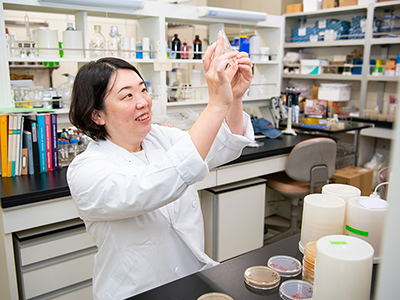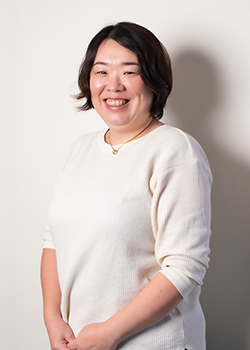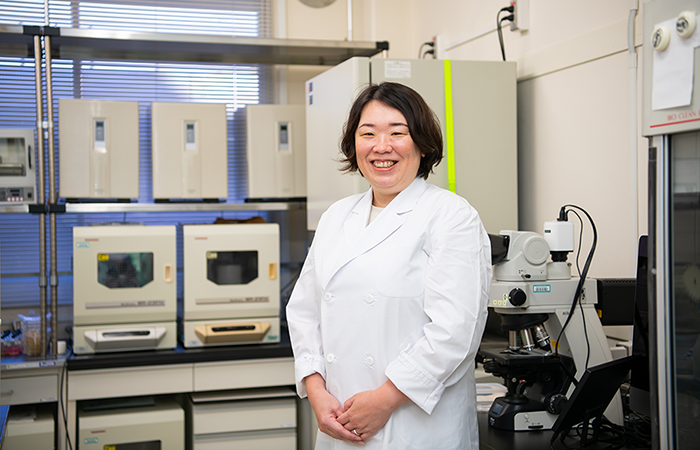Connecting Microbial Resource Maintenance Skills and History to the Next Generation
BRC is supported by a diverse staff who are involved in a variety of tasks. We have interviewed staff members from each of the 12 laboratories that make up BRC, asking them about their activities and their day-to-day efforts in their research rooms.
This time, we are speaking with Yumi Oshida, an expert technician in the Microbe Division.
In order to explore biology, in which she developed an interest during her high school days, she entered an applied microbiology laboratory while at university. Since graduating, Oshida has continued to explore the world of microorganisms at RIKEN BRC. We asked her about what led her into this line of work and what she values most.
The door into biology was opened for me when I encountered liverworts during my second year of high school.
I think I started my current job because I have been closely connected to biology and microorganisms ever since I was a child. Living things and nature have always been very familiar things to me. Back then, our house was still surrounded by fields and rice paddies, and I was in daily contact with different kinds of creatures. When I went for a walk with my parents and found an unfamiliar flower or plant along a footpath, I would ask them what it was and look it up in a small plant field guide, and I genuinely enjoyed such interactions.
My relationship with natural science suddenly became closer when I joined the biology club in my second year of high school. I had originally played badminton, but when a fellow member of the badminton club decided to join the biology club, I decided to join the biology club too.
In the biology club, we were required to write a report on what we had worked on. My advisor recommended liverworts as a research topic. I had seen many of them growing behind the house where I lived when I was little, but this was the first time I had the opportunity to get acquainted with their ecology in detail. I remember being absorbed in studying their reproduction method because it was so unique and interesting. I also have fond memories of researching the botanist Dr. Tomitaro Makino’s books in the library to complete my report during my high school days, and later, as an adult, visiting the Kochi Prefectural Makino Botanical Garden when I traveled to Kochi.
My advisor in the biology club was a biology teacher, and I enjoyed these classes so much that I decided to study the subject more deeply at university. So, I entered the Faculty of Agriculture and joined the applied microbiology laboratory. Later, I was taught by a senior colleague from my university lab who was working at RIKEN, which led me to my current job.
What I have learned in the course of performing various assignments—
I want to cherish the experiences I have gained and pass them on to others.

The Microbe Division, to which I belong, is responsible for the preservation and quality control of microbial strains collected from researchers around the world, particularly in Asia, and providing them to the research community. We currently maintain a microbial resource consisting of more than 30,000 strains.
My responsibilities here include the collection, preservation, and quality control of anaerobic bacteria, as well as following the procedures for importing and managing bacterial strains that are prohibited from being imported under the Plant Protection Law. I have been in charge of the procedures for importing these bacterial strains for the past three years, but before that I was also involved in work related to ISO 9001(*1) in the Support Unit for Quality Management. During that time, I was certified as an ISO 9001 Associate auditor and I was awarded an IATA Dangerous Goods Operations Diploma. The knowledge I gained in working to obtain these qualifications is also useful in my current job, which is related to the transportation of bacterial strains.
At RIKEN BRC, I have had many opportunities to grow through the various tasks to which I have been assigned. When I first joined RIKEN BRC, I was primarily in charge of work related to the preservation of microorganisms. I cultured lactic acid bacteria when I was a student, so I knew the basics such as aseptic techniques, but lactic acid bacteria are facultative anaerobic bacteria (*2), which differ in some basic respects from the anaerobic bacteria (*3) that I am currently in charge of.
I was taught on-site from the ground up and I learned how to do my job little by little. I was the youngest member of the team at the time, and many of the people around me were veterans close to my parents’ generation, but they treated me warmly, and I was able to learn a lot without feeling overwhelmed.
The Microbe Division has a 42-year history, and I sense that it is a place where a variety of both tangible and intangible assets are being handed down from generation to generation, including not only work-related matters but also the excitement of everyone working together toward the same goal during events. I would like to continue to cherish the attitude of sharing and passing on these things to others.
Making judgments and being prepared to go beyond what the manual says—
The things I value
In my work, there are two things in particular that I value: firstly, to take care of small things and not ignore the slightest snag; and secondly, to investigate things I am curious about until I am satisfied.
In quality inspections of bioresources such as anerobic bacteria, of which I am in charge, there are times when decisions that are not provided for in the manual are required. Although it is a matter of course to follow the instructions in the manual, there are many situations in which something not covered by the manual may occur. Even when inspections are conducted according to the manual, there are times when the inspector may feel that something is amiss, such as when the colony looks slightly different from usual. This is based on experience and intuition and is not something definite, but if you look more closely at the product without ignoring anything, you may find that there are things mixed into it that should not be there. If there is obvious contamination, we can simply reject the strain, but I always feel it takes courage to make the judgement on whether there is a problem, since variations in colonies may occur even within the same strain, and the criteria for judgment will differ from strain to strain.
Basically, such decisions are left to the staff member in charge of each bacterial strain. So, in order to make my own judgments with a sense of conviction, I seek the opinions of those around me, examine and consider various factors, and try to explain to the users confidently and sincerely. I think these aspects support the quality of my work.

Over the course of the history of the Microbe Division, the rules of work in the division have undergone numerous changes, including changes in documents and media, against a backdrop of technological evolution. As I have become an old-timer myself and the number of current staff who know about the past is decreasing, I am increasingly being asked by members of the younger generation why the past processes were done the way they were. I have also heard stories passed down from my seniors about how things were done in the days before I myself joined the division. I hope to be able to organize the things that my predecessors have cherished up to now and pass them on to future generations.
- *1 ISO 9001: The internationally recognized standard for Quality Management Systems (QMS), aimed at improving customer satisfaction with the products and services offered by companies or organizations
- *2 Anaerobic bacteria: Bacteria that grow under anoxygenic conditions
- *3 Aerobic bacteria: Bacteria that require oxygen for growth
Profile
- Yumi Oshida
- Expert Technician, Microbe Division (RIKEN BRC JCM)
- In 1999 she began to work as a temporary staff member in the Microbe Division, and in 2010 she was switched to direct employment. Currently, she is involved in tasks such as collection, preservation, and quality control of aerobic bacteria, as well as procedures for importing and managing bacterial strains that are prohibited from importation under the Plant Protection Law.
Release date : Aug 21, 2024
